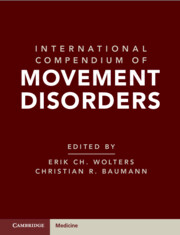Book contents
- International Compendium of Movement Disorders
- International Compendium of Movement Disorders
- Copyright page
- Contents
- Contributors
- International Compendium of Movement Disorders
- Hypo- and Hyperkinetic, Dyscoordinative and Otherwise Inappropriate Motor and Behavioral Movement Disorders
- Section 1: Basic Introduction
- Section 2: Hypokinetic Movement Disorders
- Section 3: Hyperkinetic Movement Disorders
- Chapter 36 Primary Dystonia
- Chapter 37 Secondary Dystonia
- Chapter 38 Treatment of Dystonia
- Chapter 39 Primary and Secondary Tremors
- Chapter 40 The Pathophysiology of Tremor
- Chapter 41 Treatment of Tremor
- Chapter 42 Myoclonus
- Chapter 43 Chorea
- Chapter 44 Ballism
- Chapter 45 Gilles de la Tourette Syndrome and Other Tics
- Section 4: Dyscoordinative and Otherwise Inappropriate Motor Behaviors
- Section 5: Objectifying Movement Disorders
- Movement Disorders in Vivo: Video Fragments
- Acronyms and Abbreviations
- Index
- References
Chapter 44 - Ballism
from Section 3: - Hyperkinetic Movement Disorders
Published online by Cambridge University Press: 07 January 2025
- International Compendium of Movement Disorders
- International Compendium of Movement Disorders
- Copyright page
- Contents
- Contributors
- International Compendium of Movement Disorders
- Hypo- and Hyperkinetic, Dyscoordinative and Otherwise Inappropriate Motor and Behavioral Movement Disorders
- Section 1: Basic Introduction
- Section 2: Hypokinetic Movement Disorders
- Section 3: Hyperkinetic Movement Disorders
- Chapter 36 Primary Dystonia
- Chapter 37 Secondary Dystonia
- Chapter 38 Treatment of Dystonia
- Chapter 39 Primary and Secondary Tremors
- Chapter 40 The Pathophysiology of Tremor
- Chapter 41 Treatment of Tremor
- Chapter 42 Myoclonus
- Chapter 43 Chorea
- Chapter 44 Ballism
- Chapter 45 Gilles de la Tourette Syndrome and Other Tics
- Section 4: Dyscoordinative and Otherwise Inappropriate Motor Behaviors
- Section 5: Objectifying Movement Disorders
- Movement Disorders in Vivo: Video Fragments
- Acronyms and Abbreviations
- Index
- References
Summary
Ballism is defined as a movement disorder characterized by involuntary, forceful, flinging, high-amplitude “throwing” movements. Ballism is often accompanied by choreatic movements, the latter being more distal whereas ballism describes the proximal movements. With time, the proximal ballistic movements may become less pronounced, and the distal choreatic movements predominate. Ballism increases with action and is absent during sleep. The movements can be so violent that patients injure themselves. Ballism usually affects one side of the body, and it is then referred to as hemiballism. Older terms are hardly ever used anymore – that is, monoballism if only one limb is affected, biballism if both extremities on one side of the body but not the head or face are affected, or paraballism if both sides of the body are affected.
- Type
- Chapter
- Information
- International Compendium of Movement Disorders , pp. 557 - 558Publisher: Cambridge University PressPrint publication year: 2025

